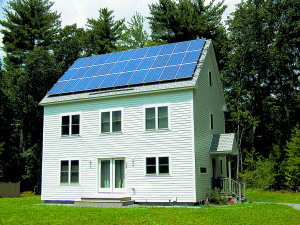By Thaddeus Rumple
A net-zero energy building produces as much power as it uses. There are a number of ways to do this. One example is a home built to Passive House standards, where costs quickly outweigh the added expense for higher building performance. Another approach is to build to a simpler and less costly high-efficiency standard, and install a renewable generating system, such as a solar array, to make up for any extra energy needed. Either way is worth any initial costs over those of conventional construction, because no heating plant is needed, which offsets the higher cost to build. The cost of renewable power has fallen to the point that a solar system is often less expensive than an oil-burning furnace and a chimney.
Here are the steps we suggest to build a net-zero home:
1. Start with a stated intention of having a net-zero design. Getting to net-zero is much easier if the home is designed to be net-zero from the start. This decision should be made clear to all involved.
2. Choose professionals who are experienced in net-zero construction. This includes architects, engineers, and contractors who will be involved in the project. Everyone must be on the same page. People should not work on the project unless they either have good experience or honestly wish to learn with counsel from someone who is.
3. The home has to be sited properly. Both the site and the orientation of the building need to be appropriate for net-zero construction. Make sure you can use the sun for passive gain. It is also advisable to include thermal masses that can store heat.
4. Determine what kind of net-zero design will be used. Will the design use Passive House standards, high efficiency with solar, or some other approach? Remember that while positioning a home on a property such that the roof is notably shaded is disadvantageous for energy production from the roof, there might be a sunnier site elsewhere on the property to get energy from a ground-mounted solar array.
5. As the design work is being done, have it modeled with a computer, so you know what to expect. Do not make changes to the basic design without re-running the numbers, as a change in design can have effects on efficiency and energy.
6. Super-insulate and super-seal, starting at the foundation, and including all exterior walls, the attic (if applicable) and all penetrations through them. This process should include consideration of any feature that might relate to the walls of the building envelope, including double stud construction, avoiding thermal bridges in framing and other building details, and giving thought to systems that typically run through the walls, such as wiring and plumbing, and anything else.
7. Use super-efficient windows and doors. It is not enough merely to buy the most efficient models available. They must also be installed and sealed correctly.
8. Use blower-door testing to make sure sealing is done properly. Do this several times, starting when it is first possible and ending when construction is completed. Keep a log of changes, as this will make it easier to find the cause of any unsatisfactory results.
9. Use solar electric and solar thermal, as appropriate. Solar space heating is also available and very inexpensive. Photovoltaic panels that supply electricity might supply enough to power mini-splits and other heat pumps for heating space and water.
10. Given a well-sealed building, it is important to manage air quality and humidity. Have an energy recovery ventilation (ERV) system or a heat recovery ventilation (HRV) system installed for those purposes. Humidity is especially important.
11. Use energy-efficient lighting and appliances.
Remember, it is possible to build a net-zero home for about the same cost as conventional construction, eliminating the costs of heating and electricity for the future. A side benefit of this is that the home is more comfortable. Why would you want to do anything else?
For another article, with a somewhat similar list, on the same subject, visit www.zerohomes.org/twelve-steps-to-zero.
Many thanks to our sponsor:










Leave a Reply